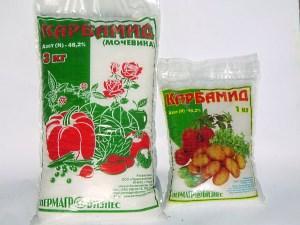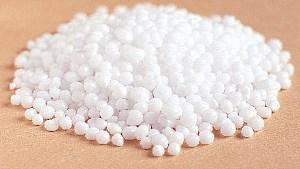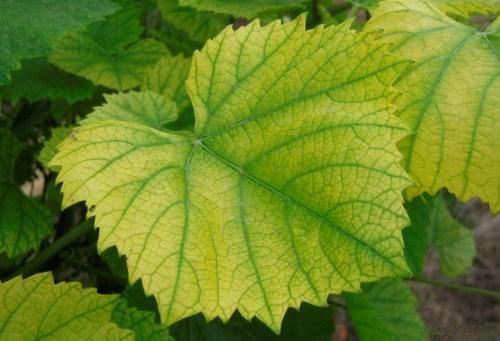Urea as fertilizer - high efficiency at the lowest cost
 Urea (urea) - widely used among gardeners and gardeners, highly effective, versatile, granular nitrogen fertilizer... With the correct and dosed, for a particular culture, the use of urea as fertilizer, plants respond with good growth and development, as well as abundant fruiting. In addition to its versatility, there are two more important factors that make carbamide very popular among farmers - urea, which is inexpensive and very affordable fertilizer.
Urea (urea) - widely used among gardeners and gardeners, highly effective, versatile, granular nitrogen fertilizer... With the correct and dosed, for a particular culture, the use of urea as fertilizer, plants respond with good growth and development, as well as abundant fruiting. In addition to its versatility, there are two more important factors that make carbamide very popular among farmers - urea, which is inexpensive and very affordable fertilizer.
Appearance, chemical characteristics and physical properties of urea

- Appearance - round, very light (up to white) or transparent granules. Granulating urea in production, to a high degree, prevents the fertilizer from caking during storage and transportation.
- Chemical characterization - (NH2)2CO, where almost half (46%) of the total is nitrogen.
- Physical properties - urea fertilizer dissolves in many polar solvents, including ordinary water, which allows it to be used both in pure form (granules) and in the form of an aqueous solution of the required concentration.
Signs of nitrogen deficiency in horticultural and horticultural crops
- Unnaturally slow, depressed plant growth.
- Thin, weak and short shoots in shrubs and trees.
- Leaves: narrow and small, light green (pale) or with obvious yellowness. Plants suffering from a lack of nitrogen are prone to early leaf fall.
- Flower buds: weak and underdeveloped, their formation occurs in much less quantity than it should be. And as a result, the plants have poor fruiting.

Instructions for the use of urea
 When using urea as a fertilizer in a vegetable garden or garden plot, it should be borne in mind that in just a few days it is transformed and modified under the influence of bacteria in the soil, during this process ammonium carbonate is released, which decomposes rather quickly in the open air, as a result of which the surface use of urea , of course, possible, but ineffective.
When using urea as a fertilizer in a vegetable garden or garden plot, it should be borne in mind that in just a few days it is transformed and modified under the influence of bacteria in the soil, during this process ammonium carbonate is released, which decomposes rather quickly in the open air, as a result of which the surface use of urea , of course, possible, but ineffective.
Optimal and better results are obtained by applying this fertilizer not only on protected soil, for example greenhouses or greenhouses, but also in ordinary horticultural farms. The only condition for the maximum efficiency of urea is its immediate incorporation into the soil, due to the fact that the loss of ammonium carbonate (gaseous ammonia) is minimized, this significantly increases the penetration of nutrients, in particular nitrogen, into plants.
Regardless of where and by whom urea is made, all manufacturers are unanimous in their recommendations and indicate in the instructions for use of urea that it can be used on any soils as the main fertilizer or as a top dressing for fruit and berry and / or garden crops.
Despite this versatility, it should still be noted that different crops need an unequal amount of fertilizer, and therefore agricultural technicians recommend adding nutritional supplements in certain doses, depending on the actual needs of the plants.
Important! Urea significantly acidifies the soil - this is a fact. If the soil is already acidic, then limestone (chalk) is used to neutralize these processes.It is applied together with nitrogen fertilizer at the rate of 0.5 kg of carbamide, 0.4 kg of limestone.
The use of urea as fertilizer in the garden and in the garden
Vegetative period
- Cabbage, beets, onions, peppers, tomatoes, garlic and potatoes - 19–23 g / m².
- When using urea for cucumbers or peas, apply about 6-9 g / m².
- Squash, eggplant and vegetable marrow - 10-12 g / m². Top dressing is done 2 times during the entire growth period, the first during planting of seedlings, and the second at the beginning of fruit formation.
- Strawberries and garden strawberries - fertilizer is introduced unchanged into the soil of the plot prepared for planting berries. During the formation of buds and ovary of berries, spraying is applied, 10 gr. for 2 liters of water. To increase the yield at the beginning of September or at the end of August, plants are fed with a concentrated solution - 60 gr. for 20 liters of water.
- Cereals - 300 gr. per hundred square meters in granular form.
- Foliar feeding of vegetable crops, as well as protection against diseases and pests (spraying of plants) - 9–15 g for every 10 liters. water.
Before planting berry and vegetable crops
In order to fertilize the land for berry and vegetable crops in the pre-sowing period, it is enough to add urea granules (without dissolving) at the rate of 5-11 g / m². As a rule, 60% of the total required volume of urea is applied in the fall, before digging, while the rest of the fertilizer is added in the spring.
How to breed urea to fertilize fruit trees and berry bushes
Important! An overabundance of nitrogen fertilizers in the soil is also not good for plants, they may begin to grow intensively with the formation of abundant green mass to the detriment of fruiting. In this case, the formation of underdeveloped ovaries and / or fruits is possible.
If everything is clear with the use of granules - I measured the required weight and everything can be added to the soil, then how to dilute urea and make a solution of the required concentration from it can be confusing for many, especially novice farmers. And this question is especially relevant for gardeners. This is due to the fact that trees and shrubs are fertilized mainly with urea diluted in water and extremely rarely granular urea - just before planting a seedling, it is laid directly into a prepared hole.
In order for trees and shrubs to develop well and bear fruit abundantly from urea, as already mentioned, a concentrated solution is prepared, which is introduced directly into the area of the roots (near-trunk circle) and into the near-trunk stripes. If, for some reason, it is not possible to prepare a solution, then granules can also be added, although this is not the best option, but at the same time, subsequent abundant watering is required. In this case, it is also important to observe the proportions of the dilution of urea.
- Apple tree - under each adult tree about 200 g of carbamide (granules) or solution - the specified amount of urea is diluted in 10 liters of water.
- Plum, chokeberry, irga and cherry - 120 g / 10 l.
Advice! Do not despair if you do not know how to use urea in the country and how to measure it correctly when there are no scales at hand.
In this case, you can use the tools at hand:
- 1 tbsp. l. holds 10 gr. urea;
- in an ordinary matchbox (without a slide) 13 grams are placed. urea;
- 200 gram glass - about 130 gr. this fertilizer.